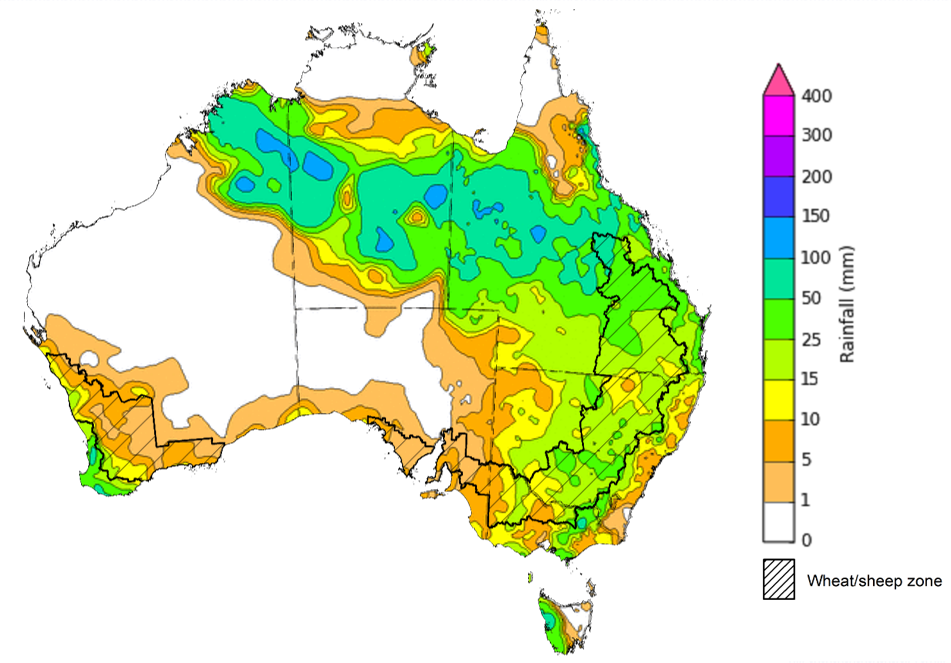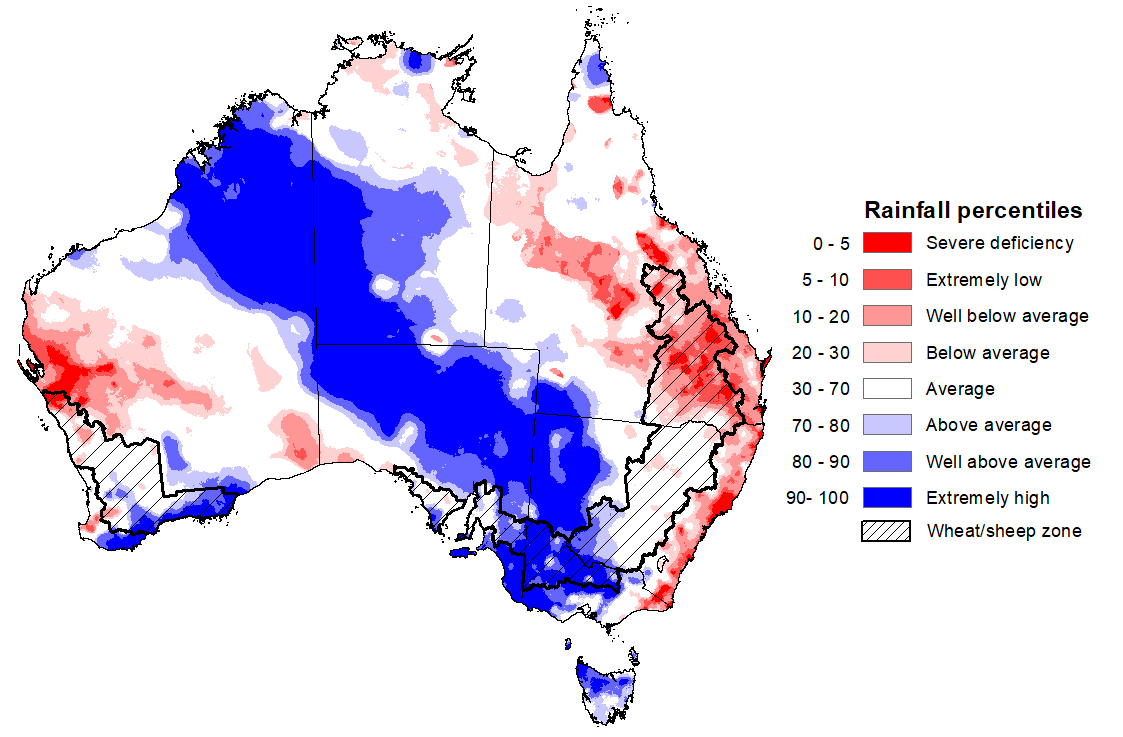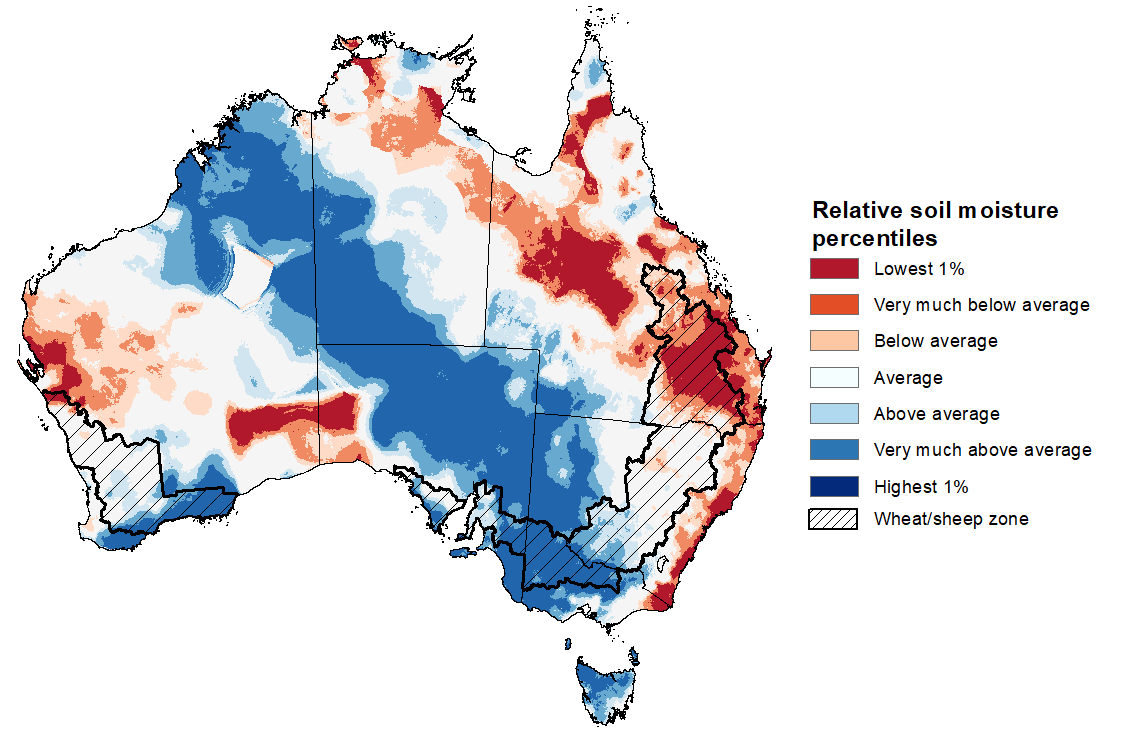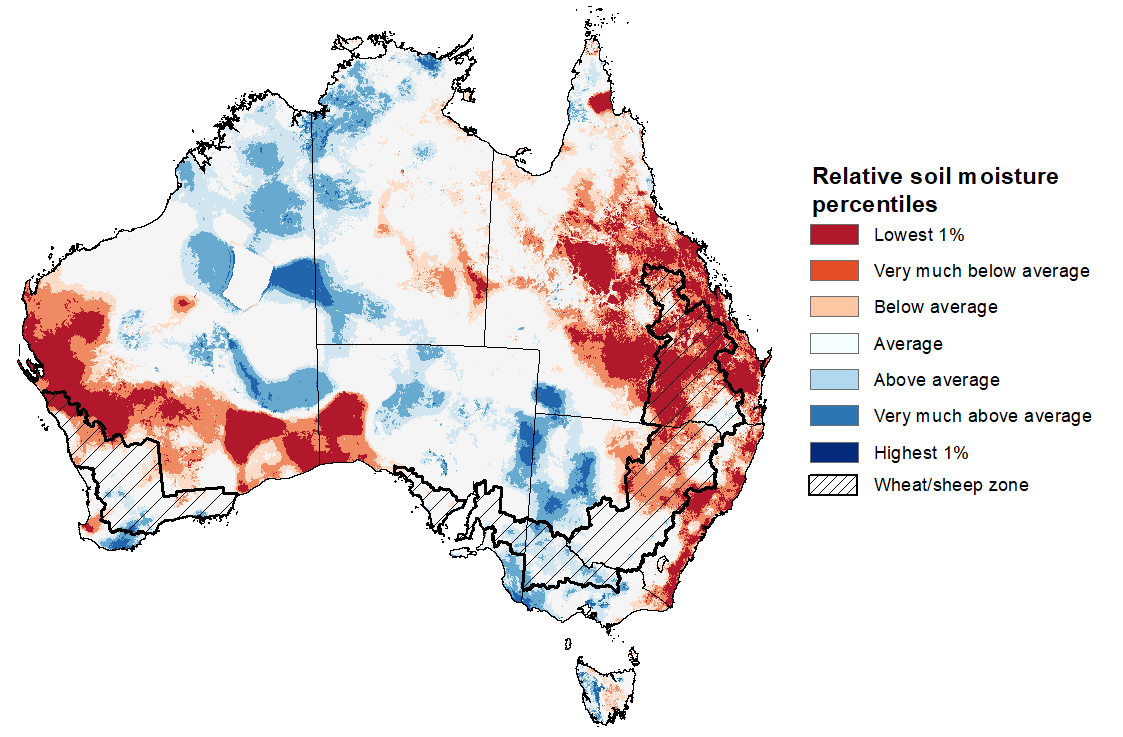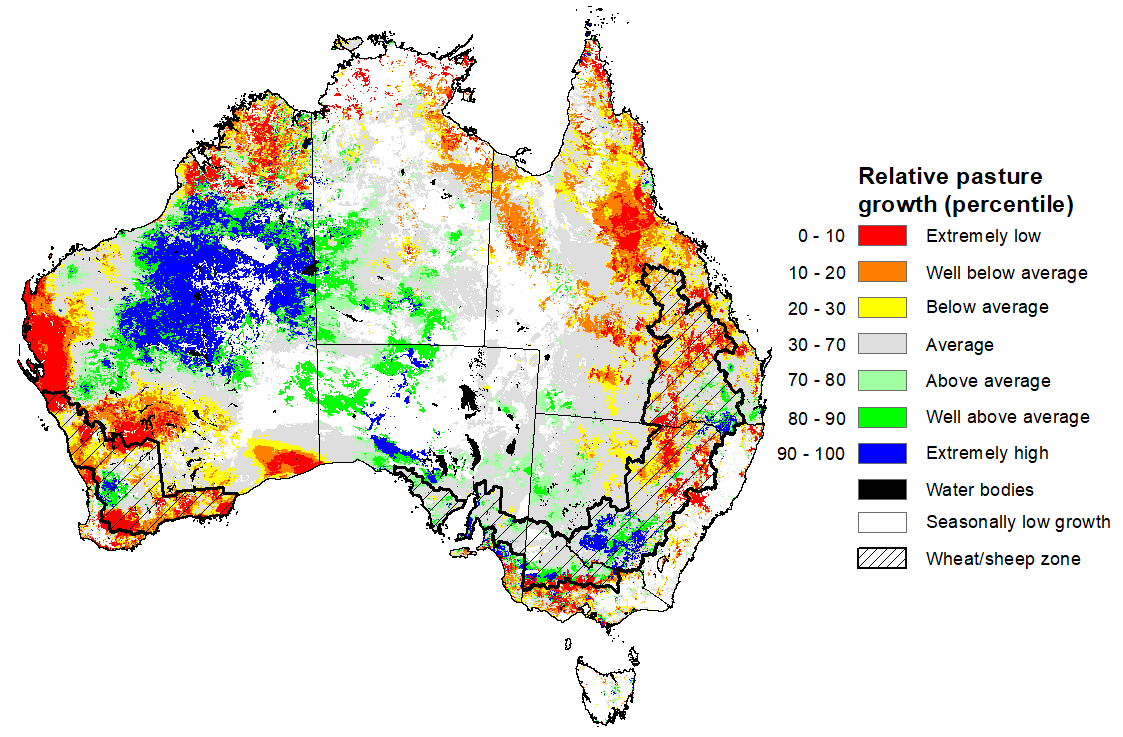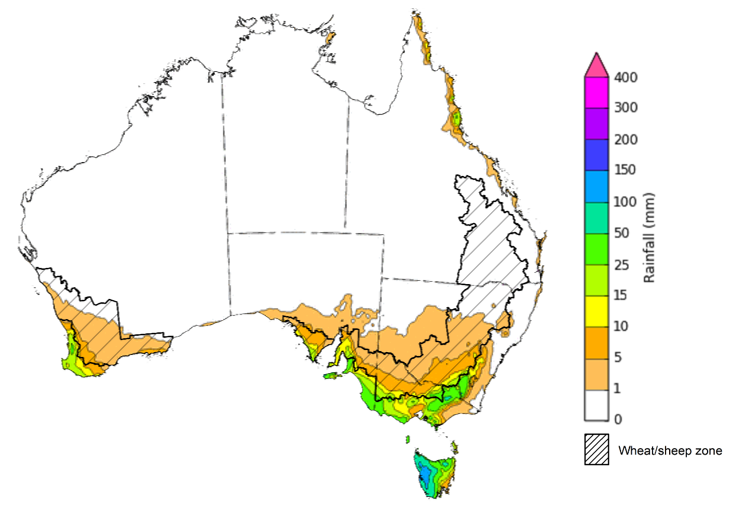Key issues
- For the week ending 5 July 2023, the northwest cloud band re-intensification brought widespread unseasonal rainfall to large areas of northern Australia, extending across northern Western Australia, much of the Northern Territory and central Queensland throughout the week. Falls of up to 150 millimetres were recorded in some areas leading to isolated flooding. The same system interacted with the moist easterly flow off the Coral Sea resulting in heavy falls in tropical coastal areas of Queensland, extending into New South Wales and parts of Victoria. Fronts resulted in rainfall in southwest Western Australia and western Tasmania.
- Across cropping regions, rainfall totals of between 25 and 100 millimetres were recorded across Queensland, up to 50 millimetres in New South Wales, up to 25 millimetres in patchy areas of Victoria and along western margins of Western Australia. Lighter falls of up to 10 millimetres were recorded in South Australia, central Victoria and much of Western Australia cropping regions. Rainfall in Queensland and New South Wales has benefitted soil moisture levels, but in many areas was unlikely to have been sufficient to link up upper- and lower-layer soil moisture levels. This would have provided some relief to any moisture-stressed early planted crops but unlikely to have provided sufficient moisture to allow for the completion of planting programs (see Section 1.1).
- Rainfall during June 2023 was around 25% above the long-term average at a national level. In cropping regions, June rainfall was extremely low to well below average across Queensland and in isolated parts of central New South Wales and north-western Western Australia. Rainfall was extremely high in southwest New South Wales, much of Victoria, and southern and eastern parts of South Australia and Western Australia. Average rainfall was recorded in the remaining cropping regions. Extremely high rainfall in Victoria, eastern South Australia and Western Australia has provided a timely boost to soil moisture levels following a very dry May and allowed for the germination and establishment of dry-sown winter crops (see Section 1.2).
- For the 3 months to June 2023, above average rainfall totals and below average temperatures resulted in above average to extremely high pasture production for this time of year across much of central Western Australia, and parts of southern Northern Territory, South Australia, western and southern New South Wales, parts of western and south-eastern Queensland, and central Victoria. This will likely enable farmers to continue to maintain current stock numbers and provide opportunities to build standing dry matter availability. Across northern Australia, below average pasture growth over the past 3 months will likely result in graziers not being able to maintain current stocking rates leading to increased turnoff. Across southern Australia, graziers will be more reliant on supplementary feed to maintain stocking rates and production (see Section 1.4).
- Over the 8 days to 13 July 2023, a high-pressure system will keep most of the country dry. A cold front and trough will bring showers up to 50 millimetres to south-western parts of Western Australia, southern South Australia and Victoria and into parts of New South Wales, while up to 150 millimetres are expected in Tasmania (see Section 1.5).
- Across cropping regions, little to no follow-up rainfall from last week is forecast for those areas of Queensland and New South Wales that recorded their first substantial rainfall in over a month. This means that in many areas that did not receive sufficient falls last week (for linking upper- and lower-layer soil moisture profiles), growers are unlikely to have the confidence to complete their intended 2023 winter crop planting programs as the window closes. Lighter falls up to 10 millimetres are expected in the remaining cropping regions, maintaining sufficient levels of soil moisture to support crop growth and development (see Section 1.5).
- Water storage levels in the Murray-Darling Basin (MDB) increased between 29 June 2023 and 6 July 2023 by 8 gigalitres (GL). Current volume of water held in storage is 20 861 GL. This is 0.4 percent or 76 GL more than at the same time last year.
- Allocation prices in the Victorian Murray below the Barmah Choke increased from $11 on 29 June 2023 to $15 on 6 July 2023.
Climate
For the week ending 5 July 2023, the re-intensification of a northwest cloud band brought widespread unseasonal rainfall to large areas of northern Australia, extending across northern Western Australia, much of the Northern Territory and central Queensland throughout the week. Falls of up to 150 millimetres were recorded in some areas leading to isolated flooding. The same system interacted with the moist easterly flow from the Coral Sea resulting in heavy falls in tropical coastal areas in Queensland, extending into New South Wales and parts of Victoria. Fronts resulted in rainfall in southwest Western Australia and western Tasmania.
Across cropping regions, rainfall totals of between 25 and 100 millimetres were recorded in Queensland, up to 50 millimetres in New South Wales, up to 25 millimetres in patchy areas of Victoria and along western margins of Western Australia. Lighter falls of up to 10 millimetres were recorded in South Australia, central Victoria and much of Western Australia cropping regions. Rainfall in Queensland and New South Wales has benefitted soil moisture levels, but in many areas was unlikely to have been sufficient to link up upper- and lower-layer soil moisture levels. This would have provided some relief to any moisture stressed early planted crops but unlikely to have provided sufficient moisture to allow for the completion of planting programs.
Rainfall for the week ending 5 July 2023
Issued: 5/7/2023
Rainfall during June 2023 was around 25% above the long-term average at a national level. Above average rainfall particularly across central parts of the country was associated with a northwest cloud band stretching from northwest to the southeast of the continent. Frontal systems and troughs led to above average rainfall in southern Australia. Rainfall was above average to extremely high for most of northern and parts of southern Western Australia, southern Northern Territory, much of South Australia, Victoria and Tasmania, part of southwest Queensland, and western New South Wales. Rainfall was below average for much of western and parts of eastern Western Australia, most of central and south-eastern Queensland and along coastal New South Wales extending into far eastern Victoria. June rainfall was generally average in remaining areas of the country.
In cropping regions, June rainfall was extremely low to well below average across Queensland and in isolated parts of central New South Wales and north-western Western Australia. Rainfall was extremely high in southwest New South Wales, much of Victoria, and southern and eastern parts of South Australia and Western Australia. Average rainfall was recorded in the remaining cropping regions. Extremely high rainfall in Victoria and in the eastern South Australia and Western Australia has provided a timely boost to soil moisture levels following a very dry May and allowed for the germination and establishment of dry sown winter crops.
Rainfall percentiles for June 2023
Upper layer soil moisture in June 2023 follows a very similar pattern to June rainfall. It was above average to extremely high for most of northern and parts of southern Western Australia, southern Northern Territory, much of South Australia, Victoria and Tasmania, part of southwest Queensland, and in the western New South Wales. Upper layer soil moisture was extremely low to below average for much of western and parts of eastern Western Australia, southwest South Australia, northern parts of Northern Territory, northern, central and south-eastern Queensland and along coastal New South Wales extending into far eastern Victoria. June upper layer relative soil moisture levels were generally average in the remaining areas.
At this time of year, upper layer soil moisture is important for the germination and establishment of winter crops and pastures across eastern and southern Australia.
In cropping regions, upper layer soil moisture was above average to very much above average across southern parts of New South Wales, much of Victoria and South Australia, and southern Western Australia. Extremely low to below average upper later soil moisture was evident across much of Queensland and in the northern margin of Western Australia. Upper layer soil moisture was average across remaining cropping regions. The above average upper layer soil moisture levels across southern cropping regions would have supported winter crops through germination and establishment.
Modelled upper layer soil moisture for June 2023
Relative lower layer soil moisture for June 2023 was highly variable across Australia. It was above average across scattered areas in northern, central and far southern parts of Western Australia, in northern and western Northern Territory, central and eastern South Australia, western New South Wales, across Victoria and western Tasmania. Relative lower layer soil moisture was very much below average for much of central and eastern Queensland, northern and coastal New South Wales, western and south-eastern Western Australia, southwest South Australia, and in scattered areas in eastern Northern Territory and Tasmania. Relative lower layer soil moisture was average elsewhere.
Lower layer soil moisture is a larger, deeper store that is slower to respond to seasonal conditions and tends to reflect the accumulated effects of events that have occurred over longer periods. Crop development and pasture growth in areas of above average lower layer soil moisture are typically less reliant on timely and frequent in-season rainfall events than in areas with below average lower layer soil moisture.
In cropping regions, lower layer soil moisture was extremely low to below average across much of Queensland, northern New South Wales and northern Western Australia. June rainfall has generally benefitted lower layer soil moisture levels across Victoria, South Australia and Western Australia where below average lower layer soil moisture levels were evident at the end of May. Areas with below average levels of lower layer soil moisture will be highly dependent on timely and sufficient in-season rainfall to support average winter crop production prospects.
Modelled lower layer soil moisture for June 2023
As northern Australia enters the dry season, pasture growth declines significantly due to the reduction in water availability, with livestock relying on pasture grown throughout the previous wet season. As south-eastern Australia enters winter, pasture growth typically increases, reflecting higher rainfall totals, and reduced temperatures and evapotranspiration rates at this time of year. Pasture availability during this period influences the growth and branding and marking rates of lambs and calves, livestock turnoff and the production of meat, milk, and wool.
For the 3 months to June 2023, above average rainfall totals and below average temperatures resulted in above average to extremely high pasture production for this time of year across much of central Western Australia, and parts of southern Northern Territory, South Australia, western and southern New South Wales, parts of western and south-eastern Queensland, and central Victoria. Average to extremely high pasture production across grazing regions will likely enable farmers to continue to maintain current stock numbers and provide opportunities to build standing dry matter availability.
In contrast, extremely low to below average pasture growth rates were recorded across much of Queensland, northern New South Wales, tropical, western and southern parts of Western Australia and southern Victoria. Across northern Australia, below average pasture growth over the past 3 months will likely result in graziers not being able to maintain current stocking rates leading to increased turnoff. Across southern Australia, graziers will be more reliant on supplementary feed to maintain stocking rates and production.
Relative pasture growth for 3-months ending June 2023 (1 April 2023 to 30 June 2023)
Source: Queensland Department of Science, Information Technology, and Innovation.
Over the 8-days to 13 July 2023, a high-pressure system will keep most of the country dry. A cold front and trough will bring showers up to 50 millimetres to south-western parts of Western Australia, southern South Australia and Victoria and into parts of New South Wales, while up to 150 millimetres are expected in Tasmania.
Across cropping regions, little to no follow-up rainfall is forecast for those areas of Queensland and western and northern New South Wales that last week recorded their first substantial rainfall in more than a month. This means that for many areas that did not receive sufficient falls last week to link up the upper- and lower-layer soil moisture profiles, growers are unlikely to have the confidence to complete their intended 2023 winter cropping programs as the planting window closes. Lighter falls up to 10 millimetres are expected in the remaining cropping regions, maintaining sufficient levels of soil moisture to support crop growth and development.
Total forecast rainfall for the period 6 July 2023 to 13 July 2023
Issued 6/7/2023Note: This rainfall forecast is produced from computer models. As the model outputs are not altered by weather forecasters, it is important to check local forecasts and warnings issued by the Bureau of Meteorology.
Water
Water storages, water markets and water allocations - current week
The Tableau dashboard may not meet accessibility requirements. For information about the contents of these dashboards contact ABARES.
Commodities
Information on weekly price changes in agricultural commodities is now available at the Weekly commodity price update.

